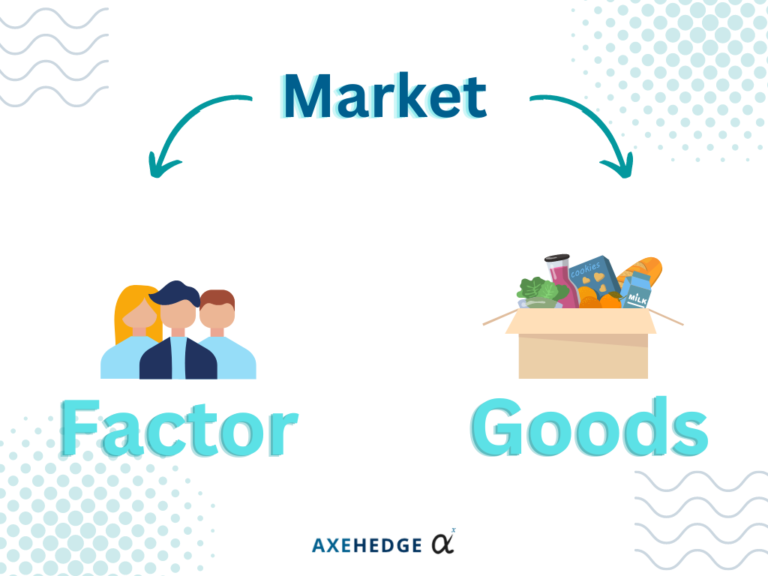
Two Types of Markets Every Beginner Should Know
Understand how Factors Market and Goods Market affect your investment.

In this article, we will get a bit theoretical, yet, we’ll make sure to still keep it relevant to the fundamentals of your investment journey. One thing that you should know is that the universe of investments rests upon one giga-pillar, the economy.
Despite all of its grandiose and big charades, the economy revolves around two simple concepts: buying and selling goods and services. It’s like a never-ending dance between households and firms.
What keeps this dance going on for ages? The answer is supply and demand. You can supply me with something that I demand? Cool! Let’s agree on the price and make each other happy!
Who are the dancers?

The dancers who keep the economy running for as long as it has been are people like you and me. However, from a more academic perspective, we are divided into two main categories: households and firms.
A household is a group of individuals living together in a single dwelling unit who share common living arrangements and expenses. Households make decisions about how to allocate their resources between consumption and saving, and they play a key role in the economy as consumers, purchasing goods and services from firms.
Or, you could just say households are individuals — people like you and me.
A firm, on the other hand, is a business organization that produces goods or provides services with the goal of earning a profit. Firms are the main producers in the economy. Firms hire workers, purchase raw materials and other inputs, and use these inputs to produce goods and services that they sell to households and other firms.
It’s worth noting that the relationships between households and firms are entirely voluntary. Firms only offer their goods for sale if they believe they’ll make a profit, and households only buy things if they believe they’re getting a good deal. This is why economics is often described as the “dance of demand and supply.” When the demand for a product exceeds the supply, prices go up, and vice versa.
Now, what this article is going for is an angle of view that is needed for you to understand the whole concept of supply and demand, we’re going to discuss the two main markets in which this whole tangos of supply and demand is going on.
And — no, we’re not talking about markets in the context of things like — the capital market, housing market, tech market, etc. What we’re going to talk about are the two main markets in which all these markets (capital, housing, tech, etc.) are included in: Factor Markets and Goods Markets.

Factor Market

A factor market is where the whole transaction revolves around factors of production. Factors of production here don’t just refer to raw materials, it encompasses everything that is needed for production to happen, like labour, land, capital and more.
In this huge spectrum of everything that gets production running, the seller here are usually individuals, where workers would ‘sell’ their labor to firms in return for wages. Farmers would sell their crops to middlemen who would then sell them to final buyers or manufacturers. Landowners would sell or lease out their lands so that firms can build their factories or offices there.
One of the most crucial branch of the factors market is the labor market. This is where households offer their labor services, and firms are the buyers. Basically, households are selling their time and skills to firms, who then use that labor to make their goods and services. The compensation paid for these labor services is a major source of income for households and a major cost for firms.
Now, it’s important to note that households don’t just spend all the money they earn from selling their labor. They often choose to save some of it, which allows them to accumulate financial capital. This financial capital can then be invested in stocks and bonds, thus generating additional income for households.
Financial institutions and markets exist to facilitate this transfer of savings into capital investments. Firms can sell debt or equity in the capital markets to raise funds for investments, like plants and equipment. They make these investments when they believe they’ll increase the value of the firm. Similarly, households can lend their savings to firms, either through banks or insurance companies, in exchange for interest.
Goods Market

Goods markets are like a giant bazaar, where firms come to sell their wares, and households and other firms come to buy them. It’s a place where people can trade their goods and services for money.
The goal of firms in the goods market is to sell their output (the fancy goods and services they’ve created) for a profit. Meanwhile, households and firms are in the market to buy these goods and services, as they believe the value they will receive from them is worth the money they have to pay.
Think of it as a big barter system, where everyone tries to get the best deal possible. Firms only offer their products for sale if they believe they will receive more money than the cost they incurred in producing them.
On the other hand, households and firms only buy goods and services if they believe the value they will receive is more than the money they have to pay. If a household values a product more than the firm selling it, an exchange can take place and both parties will be better off.
Goods markets are where the magic of economics comes to life. Whenever the demand for a good is high (people want it more), the price of that good will increase, and firms will respond by producing more of it.
Conversely, when the demand is low (people want it less), the price will decrease, and firms will produce less. This delicate balance between supply and demand is what keeps the goods market moving, and what makes it such an exciting place to be.
How does it relate to my investment journey?

It’s important to know that households and firms are actually in control of the goods market. They make the decisions on what to buy and sell. These decisions will then drive how the prices would look like.
For example, if households start to buy more electric cars, the demand for electric cars will increase, and the price will go up. This will incentivize firms to produce more electric cars, and the market will continue to grow.
Another interesting thing about the goods market is that firms compete with each other to offer the best product at the lowest price. Firms are always trying to find new and innovative ways to produce their goods and services, to make them better and more affordable for households and firms. This competition is great for consumers, as it means that they can always find the best product at the lowest price.
So, what does this mean for your investment? Understanding the goods market is critical for making informed investment decisions. If you can identify which goods and services are in high demand, and which firms are producing them, you’ll be able to spot potential investment opportunities. This can help you make smart investments that will bring in big returns.
Alternatively, factor market will definitely affect firms’ profitability. The higher the number of people at work, the more money these people can spend to buy goods. The more expensive supplies of raw materials are, the fewer profits firms will make.
Bottom Line
In conclusion, by understanding the revolving dynamics between the factors market and goods market, you will be more cautious about where the balance between supply and demand drives prices, and where competition between firms leads to stock price movements.
Understanding these two markets is crucial for making informed investment decisions as an investor. So, keep your eyes and ears open, and always be on the lookout for the next big thing in these two economic dance halls!
Do keep an eye out for our posts by subscribing to our channel and social media.
None of the material above or on our website is to be construed as a solicitation, recommendation or offer to buy or sell any security, financial product or instrument. Investors should carefully consider if the security and/or product is suitable for them in view of their entire investment portfolio. All investing involves risks, including the possible loss of money invested, and past performance does not guarantee future performance.






